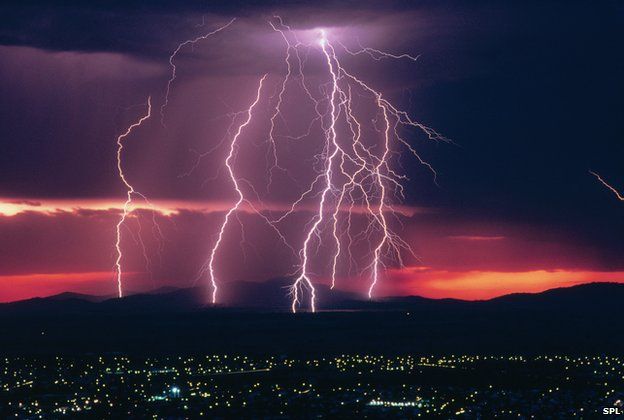Gamma-ray bursts 'common in storms'
- Published

Scientists have shed light on a mysterious phenomenon that occurs in thunderstorms.
They have discovered that gamma-ray bursts - the most powerful explosions of energy in the Universe - are far more common on Earth than was thought.
Data from Nasa's Fermi satellite shows that all storms produce the blasts and an estimated 1,100 occur each day.
The findings were presented at the American Geophysical Union's Fall Meeting.
Until recently, it was thought that gamma-ray bursts were only found in deep space.
The pulses of high-energy light are hurled out when giant stars explode or black holes or neutron stars merge.
But in the 1990s, scientists found that these events also occur in the Earth's atmosphere during storms, although it was thought they were rare.
Now, new research has revealed that almost every type of storm - no matter what its strength - produces these invisible explosions.
The Fermi space telescope measured the outbursts rising up and out of the atmosphere, while lightning arrays down on Earth helped scientists to pinpoint the types of storms that were producing them.
Prof Joseph Dwyer, from the University of New Hampshire in the US, told the BBC: "These are big, monster bursts of gamma rays, and one would think these must be monster storms producing them.
"But that's not the case. Even boring-looking, garden-variety, little storms can produce these.
"Any kind of storm seems to produce these terrestrial gamma-ray flashes."
Based on the satellite data, scientists estimate that 1,100 of these outbursts occur each day, although the number may be greater because the satellites cannot detect every event.
In more research presented at AGU, scientists looked at another high-energy event associated with storms: X-rays.
By undertaking the highly risky endeavour of flying a plane through a thunderstorm, researchers from the Netherlands and France confirmed that lightning was indeed producing X-rays.
"The X-rays coming from the lightning could act as the seed for the terrestrial gamma ray flashes," added Prof Dwyer.
Scientists do not believe gamma-ray bursts pose a danger to planes - as pilots avoid thunderstorms.
Even if a flight was caught by one, the mechanics would not be affected, said Prof Dwyer.
However, passengers and cabin crew would be exposed to a higher than usual dose of radiation.
Follow Rebecca on Twitter
- Published21 January 2013
- Published21 November 2013
- Published11 January 2011